Three Years of Podcasting: What Have I Learned?
An unexpected layoff, an email to a famous actor, and the 99 episodes that followed
Welcome to another edition of Willoughby Hills!
This newsletter explores topics like history, culture, work, urbanism, transportation, travel, agriculture, self-sufficiency, and more.
If you like what you’re reading, you can sign up for a free subscription to have this newsletter delivered to your inbox every Wednesday and Sunday and get my latest podcast episodes:
May has become a special time for me in recent years. This month marks two milestones, neither of which I ever expected to reach. May, 2023 is the three year anniversary of my start in podcasting and later this week, I will also release my 100th episode!
For the 100th episode, I am very excited to announce that my guest will be none other than
! We’ll be discussing his live stage show, his philosophy on life and love, and his study of agrarian author Wendell Berry. This is Nick’s second appearance on the podcast and this was possibly my favorite conversation with any guest to date.As a reminder, paid members of Willoughby Hills get priority access to every new podcast episodes (plus other benefits). Members will have a special link to Nick’s interview beginning tomorrow (May 8), with the episode available to the public on all podcast platforms on May 11. If you’ve been on the fence about upgrading your membership, I hope this is a good incentive to take the plunge!
And to those of you that are already paying members, your support helps keep this newsletter and podcast going strong, so thank you!
Since many of you reading this may know me more for this newsletter than for the podcast or any of my past work, I thought it might be interesting to look back on the origins of the podcast, share some my approach and methodology in creating the show, look at the lessons that I have learned over the last three years, and discuss why I continue to produce it. I hope there are lessons in here that you can bring to your own creative endeavors.
The Origins
On the morning of March 12, 2020, I was called into my boss’s office at This Old House Productions, where I had been producing for 15 years. As I entered, I saw that there was also a member of management from our Stamford, CT office seated and I immediately knew what was happening. “Oh, it’s that conversation” I said aloud, knowing that my time at the show had come to an end.
The world was already feeling a little strange, with the threat of this new “coronavirus” being talked about heavily on the news, but it was still an abstract idea. Earlier in the week, I had stopped shaking hands with people out of precaution, but otherwise life felt relatively normal. Of course, within a matter of days, everything was shut down. My daughter’s school closed, my wife began working from home, and most meaningful work in my industry of TV and video ceased production.
By the late spring, a few shows started to pivot to remote production, sometimes very awkwardly, sometimes quite successfully. Trevor Noah began to film short monologues for The Daily Show from his apartment which at first were only shared on social media before becoming network programming. Other late night shows, news programs, and more followed suit.
Even though I had only been out of work for two months at that point, I could feel a fundamental shift happening in the industry. As production went remote, I was not at the table and had no idea what the new reality looked like. I wanted to learn about the procedures teams were following, the new cameras, and new software that allowed shows with a crew of dozens in a studio to be made by a single host at home. I worried that when I went back to work someday, my experience might no longer have been relevant.
I had the idea of starting a podcast about how the entertainment and media industries were adapting to the pandemic and discussed it with my wife. I was unemployed and not knowing how long that would last, I didn’t want to spend money on unnecessary things. Fortunately, she loved the concept and encouraged me to pursue it, even though it would take some money to get started.
I knew that I wanted something that sounded professional and I put together a package of gear for about $600 and set up a small studio in the corner of our attic. It felt like a big gamble, especially since I didn’t know the first thing about producing a podcast or even exactly what the show should be beyond a rough concept.
The First Episode
From the beginning, I imagined that the most acute phase of the pandemic would only last for a few weeks and that offices and productions would be back to normal very soon. My thought was to produce a very limited series, maybe 10 episodes at the most, that chronicled what I believed to be a brief blip on the radar.
I thought I would mostly just interview my friends to hear their experience with the pandemic: Boston-based directors of photography, audio engineers, grips, gaffers, folks like that. The names would not be especially recognizable and my intended target audience would be primarily the Boston production community.
As I was developing the concept, I remembered seeing some posts back in March on social media from Scott Foley. He was traveling to Chicago to shoot a pilot and then abruptly returned to Los Angeles as the shutdown started. I didn’t know Scott well, but he and I were mutuals on Twitter and we had exchanged emails during my time at This Old House after he appeared on Ellen and made a “This Old House audition tape.”
I thought Scott might have a story to tell about how the shutdown affected his career, but I was nervous about reaching out. He barely knew me, the equipment that I purchased had just arrived two days earlier, and I had no track record to speak of when it came to being a podcast producer or host.
I debated if I should write to him, but I decided that the worst he could do was ignore my email entirely or politely decline. After some hesitation, I hit send on a message at 3:38pm. At 3:43, Scott sent a very nice response, which included this:
“I’m totally game to do your podcast... Let’s set something up and I’ll make myself available.”
We planned to record a few days later and I quickly scrambled to learn my new equipment. I called my dad a few times and recorded the phone calls between us. I wanted to ensure that he could hear me and I could hear him. I read through as many of Scott’s social media posts and watched as much of his work as I could to prepare for the interview.
I also set up a call with my friend Scott Carty, a Seattle broadcaster who had recently pivoted to podcasting, to ask his advice about web hosting services for podcasts. He was instrumental in helping me find the right fit. (Scott Carty later pivoted again and is now a builder. He was also a guest on the podcast later).
As soon as Scott Foley joined the call, he was warm, friendly, and as interested in hearing my story as I was interested in hearing his. I was immediately put at ease and realized that there might be something to this podcast. At the end of the call when I downloaded the files from my mixer to my computer, I optimistically labeled the folder as “001 Scott Foley.” I could have called it “1” or “01” but something about it made me think the show could possibly number into the hundreds of episodes some day so I went with three digits.
I went back and forth about the name a lot. I planned on something with an industry connotation like “Hold the Work” or “Hold the Roll” since work was literally stopped by the pandemic, but my wife helped me come up with the name Quarantine Creatives.
As much as I liked the idea of making a local podcast for local crews, having Scott Foley as my first guest changed the trajectory of the entire show. I realized I could be speaking to members of the industry across the country and that there might be an appetite for well known people in media and entertainment to share their perspectives. The series was taking a hard left turn and I suddenly needed to learn how to pitch guests and to aim as high as I could.
Pitching, Booking, and Getting Rejected
The first several guests on the show were people that I knew; some quite well, some through mutual friends, or some just through social media. The first complete stranger that I pitched was Eddie Sotto, who was a theme park designer that started at Knott’s Berry Farm before spending a long career at Disney, leading the construction of Main Street at Disneyland Paris.
I had emailed him through his website, then left to take a walk with my wife and kids, figuring he wouldn’t respond for a few hours or days, if at all. A few minutes into the walk (and maybe 20 minutes after sending the pitch) my phone rang and the caller ID showed a California phone number. On the other end of the phone was Eddie, who was interested in the pitch but wanted to feel me out before committing. We talked for about a half hour on that walk and then we set up an interview.

Over the next few weeks, I had an unbelievable run of good fortune. At some point years ago, Roy Wood Jr. and I followed each other on Twitter, though we didn’t interact much. I decided to send him a DM and see where it would go. It took him a few days to respond, but he gave me his email address and asked me to email the pitch. A few weeks later, we were talking about his tenure at The Daily Show and his thoughts on the future of standup comedy in the face of the pandemic.
I had gotten to know Nick Offerman a bit through This Old House, and decided to reach out to his team. I didn’t expect it to go anywhere and wasn’t sure if he even remembered me, but I was a bit floored when I received this response:
“I just followed up with Nick and he said he could possibly fit this in next Wednesday at 10am. Does that work for you?”
Um, yes. Sunday at midnight or Tuesday at 5am also works. Literally name the time and I would make it work!
Over the course of the pandemic, Nick and I have connected a few times, including for this week’s new episode. I expected when my tenure at This Old House ended that relationship would fizzle, but it has actually gotten stronger as we’ve realized we have more in common than just woodworking.
The remainder of 2020 was filled with conversations with people that I never dreamed would make the time for an interview and who were willing to be vulnerable on the show: Ginger Zee from Good Morning America told me about the weather studio that ABC built in her basement but also talked about some of her mental health struggles. Tom Ashbrook opened up about being fired from his longtime NPR radio show and the loss of his wife to cancer. John Tesh shared his story about surviving cancer and how his faith and politics can sometimes be at odds.
I was joined by Michael Zegen and Marin Hinkle from The Marvelous Mrs. Maisel, a huge number of contributors to The Daily Show (including correspondent Desi Lydic, show co-creator Lizz Winstead, and former producers Alison Camillo and Kahane Cooperman), and HGTV’s Erin and Ben Napier, whose episode’s popularity surprised and delighted me (it remains the most popular episode of the show by quite a margin).
I want to be careful not to toot my own horn too much. After all, I think I just happened to be in the right place at the right time. The show’s concept was on a lot of industry minds and it was during a period where people’s calendars were more sparse than usual. It was humbling that so many brilliant minds that I admired made themselves available to talk.
But there was also rejection. And a lot of it.
I emailed representatives for countless actors, producers, directors, and reporters that I thought would have an interesting story to tell and was told no. I reached out to authors, musicians, and podcasters who seemed on board and then changed their minds. Many, many, many emails went completely unanswered.
I once traded messages directly with a major Hollywood producer who was responsible for one of the most successful TV shows of all time. This person seemed willing to be a guest, but only on the condition that we not speak about the pandemic, which was the central theme of the show. It never resulted in an interview.
In the beginning, when I thought the pandemic would be over quickly, I recorded and released two shows per week, thinking this idea had a limited shelf life. I wanted to capture as many stories as I could for posterity. As the pandemic dragged on, I slowed down to one episode per week. The show went away for a time in 2021 when I got busy with other projects, then came back and fizzled out again in 2022. People were less interested in discussing COVID at that point and what were once ad hoc solutions to an unexpected problem were developing into industry norms.
I decided to start recording new episodes again earlier this year after rebranding both the podcast and newsletter to Willoughby Hills. This came on the advice of Substack co-founder
, who thought that referencing the quarantine was no longer a strong title and suggested a new name might change my focus in a positive way.By making the main subject something beyond the pandemic, I was suddenly creatively recharged and ready to start recording new shows again with clarity of purpose. This new frame was more encompassing. I could expand my potential guest pool, speak on other issues that make me passionate, and revisit past guests through a new lens.
My Lessons from Podcasting
There are a few takeaways that I have learned over the last three years that I think could apply to other creative endeavors too:
Growth takes time: Despite having some big name guests and a show that was timely to the news cycle, it has still taken a lot of work to build an audience. Unlike on YouTube or other social media, people rarely discover a podcast by algorithm. As a result, audience numbers can take a long time to build and reach any critical mass. My show is still firmly niche, but I’ve grown to be okay with that. The podcast may not be well known or matter to everybody, but it matters a great deal to the people that value it.
Podcasting is about passion, not money: When I first launched the podcast, I was imagining that I would be reading ads for Square Space and Stamps.com before too long. While I was able to secure one sponsorship deal for a few episodes and have offered Substack subscriptions directly to audience members, those endeavors just cover the costs of making this show. I had to quickly disavow myself of the notion that this could be a lucrative career or even a profitable side hustle and instead have approached it as a passion project to put good things in the world. Sometimes when you put good things out with no expectation of a return, good things return to you tenfold, and not always in a monetary sense. I have made many new friendships because of this show and learned a ton. I sometimes refer to the podcast as my graduate school. This is harder to quantify but ultimately pays dividends that go beyond the financial.
Pay for quality where it counts but don’t where it doesn’t: One of the reasons I spent $600 on podcasting equipment was because there were tens of thousands of amateur podcasts out there that are nearly unlistenable because the quality is so poor. I wanted my show to sound like listening to the radio, so I opted for decent equipment that would suffice without breaking the bank. But I chose to save money in other ways, like editing on the free software Garage Band rather than pay for Pro Tools or Adobe Audition. I thought the audience would be much more sensitive to bad sound quality than not-quite-pro edits, and I learned how to mask most of my editing in Garage Band so it sounded pretty good.
Rejection is a major piece of it: I’ve had guests that want to be involved but don’t have time in their schedule, guests that express an interest then ghost me, and emails that simply never get a reply. I learned in TV production, when I had to do a lot of the rejecting of others, that rejection isn’t personal and it’s a part of the business. Realizing that the stars need to align about 100 ways for a recording to work, I’ve never allowed myself to get too heartbroken if an interview can’t happen. There is always another equally interesting guest waiting to be found.
Send thoughtful pitches: Perhaps part of the reason I’ve had success in booking guests is that I try to send thoughtful and personalized pitches. I always ensure that I have some idea about who I’m pitching and why I want that person as a guest. If an email sounds like it was written just for you by another human, you’re more likely to respond. If it feels like a mass email, it’s more likely to be ignored.
Do your homework…: Once a guest is booked and the interview is scheduled, I make it a point to try to get into their mindset as much as possible. I look back at their social media feed to see what they’re choosing to share with the world. I read or listen to other interviews they have done. If they’re an author, I try to read their entire book before the conversation. If they’re an actor, producer, director, or other filmmaker, I watch as much of their work as I can. I write up a list of questions and notes in advance and try to imagine some kind of narrative arc for the interview.
…Then forget your homework: When I’m recording an interview, I’ve learned that the most important thing I can do is be present in the moment and listen to the guest. I’m not going to lie, this can be challenging. I try to be open to the conversation going in a very different direction than I had intended because of something a guest says. Interviews where I can only ask 1/3 of my intended questions are some of my favorite ones, because they contain surprises that only could have happened by being open, flexible, and present.
After that first episode with Scott Foley, I decided that my podcasting career might one day reach the triple digits. That day has arrived three years later. I have no idea if this show will make it to 150 or 200 episodes someday, but for now, I am enjoying the ride and I appreciate all of your support over the years!

What are your thoughts? Have you ever considered starting a podcast? Have you been listening since day one or is this show a new discovery? I’d love to hear from you in the comments!
Thanks for reading Willoughby Hills! Subscribe for free to receive new posts and support my work.
Related Reading
Before TikTok, There Was Channel 32
Wednesday Walk: Nick Offerman and My Wife
If you’ve missed past issues of this newsletter, they are available to read here.


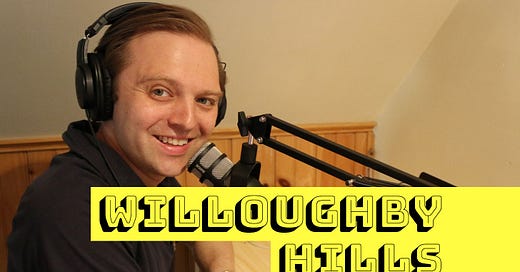


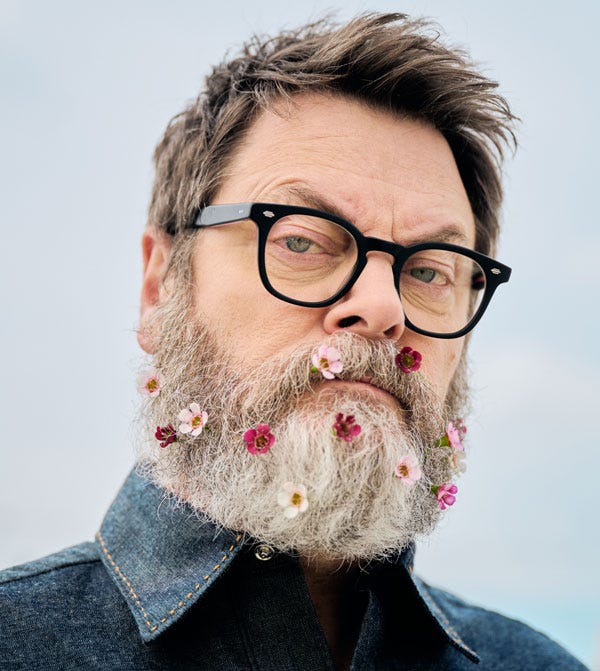
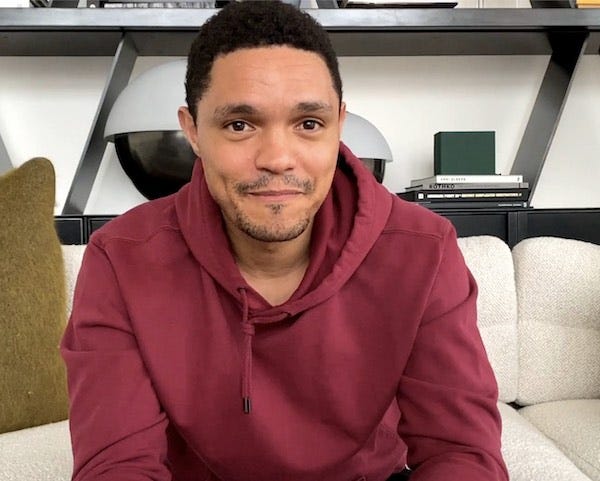
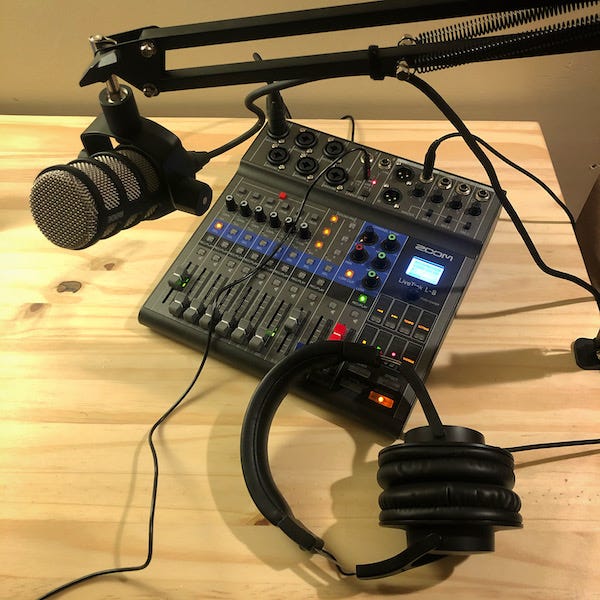


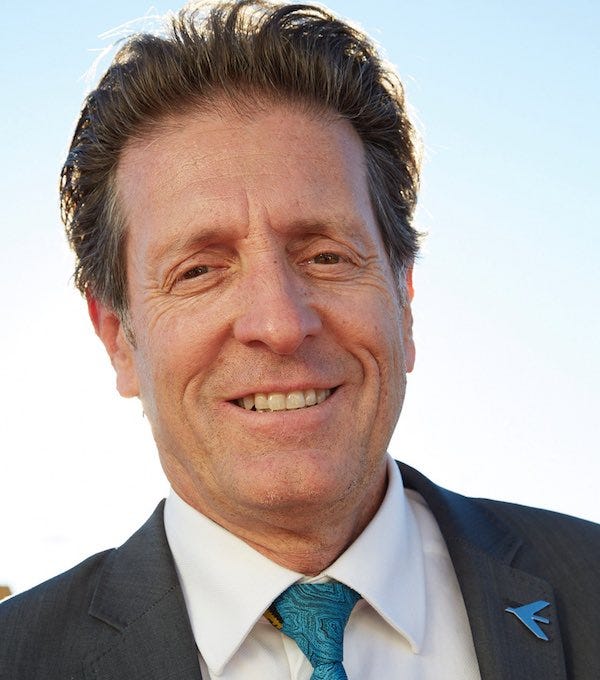
This is great. I just launched a newsletter/podcast in January on here and yea I’m beginning to understand that podcasting is a long game. Right now I’m just starting in close there are a lot of wonderful humans with incredible insights into the human experience that are not in the “famous” category. I have been looking but it would be cool if substack had a place for the podcasters to share info together. Thanks for this. So helpful in managing expectations.
The doing and forgetting homework is so important. It pains me when I hear a host stammer around because they clearly don't know good questions to ask. It's similar to stand up comedy or public speaking. By the time the person's on stage, they sound conversational and natural. The prep is invisible.